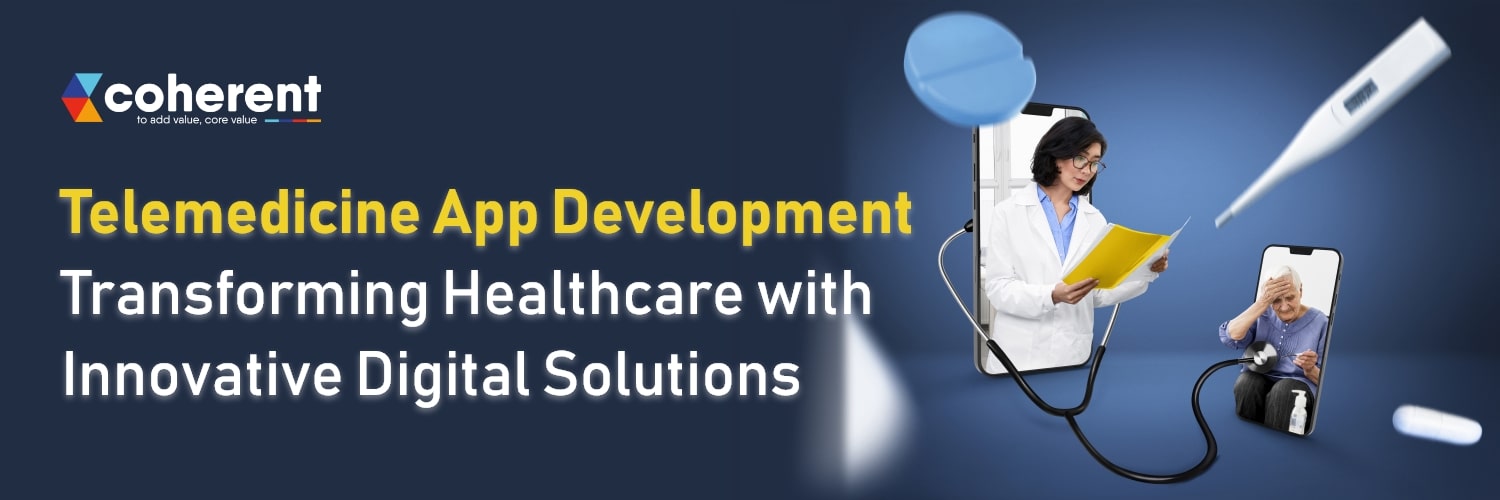Telemedicine App Development: Transforming Healthcare with Innovative Digital Solutions

Telemedicine transformed healthcare so people can obtain necessary medical services readily and rapidly and fill in for gaps found between areas and cover the challenges behind healthcare facilities and enable the time to consult and reach the patients at whatever time needed. Just a Big Thanks to telemedicine app development, people can monitor their health in real-time and have consultations from a distance. Healthcare is finally accessible to everyone i.e. it's affordable, easy, and available right at your fingertips! To know more about the development of telemedicine apps read this blog till the end.
Telemedicine App Development Meaning
Telemedicine app development is the development of digital health platforms that bring patients together with doctors at any time and at any place. It has made it possible to change healthcare through healthcare app development to have remote consultation, real-time health monitoring, and access to medical services with more ease. Today, when every convenience is an utmost need, telemedicine cuts down barriers by bringing quality care to everyone. What is telemedicine app? Let's explain it. Telemedicine App helps from video calls with healthcare specialists to AI-powered diagnostics. These telemedicine apps are also bringing the future of healthcare right on our fingertips and thus are changing the face of how we experience medical care.
Read More: A comprehensive Guide on Healthcare App Development: The Upcoming Future!
Role of Telemedicine App Development in Healthcare
The telemedicine app development is changing the face of health care to become more available, affordable, and efficient. It does this in the following ways:
Making Health Care More Accessible
Opportunities for patients in rural, urban, and small-town can now be tapped through these telemedicine apps developed by the leading telemedicine app development company, allowing them to reach specialists in other areas through video calls or chats for proper medical care, after which they may not have to travel far and wide.
Enhancing Efficiency in Healthcare
A telemedicine app, developed by telemedicine app developers, ensures efficiency in general provision as it involves all activities ranging from booking an appointment, storing patients' records, and giving e-prescriptions. In this situation, doctors will reach more people while spending less time and keeping services offered like health services to the patients.
Facilitating Long-term Treatment
Telehealth app development helps in continued follow-up and monitoring of patients who have chronic diseases such as diabetes or asthma and high blood pressure. They are thus on their medication and health issues can be diagnosed before the patients become critical.
Assistance in Emergencies
Telemedicine apps, supported by telemedicine app development services, ensure continued healthcare support during pandemics, disasters, and other crises. For example, during the COVID-19 pandemic, millions of patients accessed virtual doctor consultations from telemedicine applications while minimizing hospital visits or lowering risks of infection.
Steps to Develop a Telemedicine App
The telemedicine app development is quite complex and usually ranges between six to twelve months. However, based on the scope and complexity, there is usually a defined timeframe for such projects. What's best, therefore, is to follow a structured approach. Here are the necessary steps in the development process of a telemedicine app:
Validate Your Concept
Before you start developing, find out what your app is going to do and whether that is realistic. Just state the specific problems that the telemedicine solution will address and identify your target audience. At this step, it is very important to engage with potential users who would understand your expectations, technical proficiency, and willingness to pay for the service. Besides, analyzing the competition, you can find out what people do well at that point and where your application would be of advantage. An android app development company can be considered beneficial while gathering and analyzing this information.
Assess Your Resources or Partner with a Tech Firm
The decision regarding whether to develop the app in-house or engage an external tech partner should be made at this step. When your team doesn't have specific experience in the development of healthcare software, the work might have to be outsourced partially or fully. This is also very helpful for medium and large-scale projects and in such cases where there is already a team working on the project to ensure that you are not departing from health regulations while making sure that the execution is smooth. An iOS app development company can also provide valuable expertise in such scenarios.
Design the Application Structure
The structure of the application is one of the critical phases in the development process. The structure is different for each project, and hence, the presence of a systems structure is necessary. The Systems Structure is the one which bridges the gap between technical requirements and business objectives, thus providing a well-structured system. The structure should include core functionalities for patients, healthcare providers, and administrators and essential features like communication tools, APIs, microservices, cloud integration, and secure data storage. An ai app development company can help implement intelligent automation and data-driven solutions to enhance the system’s efficiency and functionality.
Design the UI/UX
The importance of a good UI/UX design cannot be overdone; as an app user, you probably know that design is the most important aspect of software product success. It is especially critical when targeting a casual audience who may not have deep technical knowledge. The application needs to have a user-friendly and easy-to-read interface on every platform so that all telemedicine capabilities are readily available with a minimum number of interactions.
Develop Your Software Solution
It is the phase when you realize your project is in action. A wise strategy is to start with an MVP to test user acceptance and then continue to evolve the solution by adding more features. While dividing the development process into two stages will increase the initial cost of developing a telemedicine app but it may save significant mistakes in the future. The key at this stage is that your app must be developed within the set timeline and align with the initial specifications.
Quality Assurance
This implies testing the readiness of your application before its deployment into the market. This will be best undertaken by thorough testing of the software. Depending on the specifics of your project, it may comprise functional testing, user acceptance testing, compatibility testing, localization testing, security testing, and UI/UX testing as well as other activities, including smoke testing and setback testing to ensure your software build is stable and working well. A mobile app development company can assist in conducting these tests to guarantee optimal performance and user satisfaction.
Deploy Your Application
Once all the development and testing stages are completed, it is time to launch your solution. This would include launching your application to the App Store and Google Play Store, and then you could share it as a web application. You will then have to launch a marketing campaign to make the most of exposure and expand the number of users gradually. However, your work does not end here; you are to maintain it by constantly updating your application, improving its usability and new features, and considering customer feedback actively to be competitive in the telemedicine market.
Future of Telemedicine Apps
Artificial Intelligence, wearables tech, and IoT integration would further enhance the applications of telemedicine. Telemedicine App Development would be very effective with more innovations like remote diagnostics, health recommendations by artificial intelligence, and predictive analytics.
You would place your business ahead of the digital curve in case you begin investing in telemedicine app development. Properly developed, it could lead to the creation of a powerful, agreeable, and user-friendly telemedicine web app and meet ever-growing demands for virtual healthcare services.
Also Read: Fitness App Development – A Comprehensive Guide
Excited to Develop Your Telemedicine App?
As you read, telemedicine app development can make the healthcare services accessible, efficient, and cost-effective. For creating a telemedicine application, proper planning, relevant technology, and following rules with all the regulatory requirements are very important. You will be able to develop a smooth and secure digital healthcare solution with validation of the idea, selecting the best approach for development, and incorporating crucial features. Partnership with professionals would ensure a successful and smooth launch. Digital is the future of healthcare—be ready and make your mark. Looking to develop a cutting-edge telemedicine solution? As we're a foremost mobile app development company, we are here to transform your healthcare vision into reality.
Frequently Asked Questions (FAQs)
Q1. How much does telemedicine app development cost?
Developing telemedicine software will likely range from $50,000 to $300,000. Cost will depend upon the features you want, the complexity of your telemedicine application, the amount of regulations it needs to follow, and your development team's rates. Apps that are using AI or connecting with electronic health records and offering real-time monitoring will likely be more expensive, but much simpler apps tend to be cheaper.
Q2. How much time does it typically take to develop a telemedicine app?
From the planning stage, it takes six to twelve months before the telemedicine application is launched.This involves a few stages of preparation, determining the actual UI and experience design, building up both the back and front ends of the project, integrating a few APIs, reaching a testing phase, and finally determining if it complies with the local laws and policies regarding such apps or not. So, very advanced apps take significantly more time.
Q3. What security measures should a telemedicine app have?
The program should ensure multi-factor authentication, end-to-end encryption, secure data storage, and following rules with HIPAA and GDPR to protect private health data. Scheduled security audits, firewalls, protected APIs, and role-based access control are further recommended security procedures. Thus, a strong cybersecurity system indicates that all patient data, medical consultations, and payments must be kept private and safe from interruption.
Q4. Is it necessary to follow HIPAA regulations for a telemedicine app?
This is quite assured if the patient's information is safe with any telemedicine app as long as that particular app follows HIPAA guidelines. You are required to employ safety features, such as encryption, user authentication, and log audits, which, when violated, result in legal restrictions.
Q5. Can telemedicine apps integrate with wearable health devices?
Yes, the telemedicine application does integrate into wearable health devices that include smartwatches, medical sensors, or fitness trackers to track health monitoring in real-time, tracking a patient's heartbeat, blood pressure, glucose level, etc. It shares details that improves remote patient care and makes early diagnosis and delivers personalized treatment to enhance healthy outcomes of patients through artificial intelligence-driven real-time monitoring insights.

 +91 774-202-1725
+91 774-202-1725 business@coherentlab.com
business@coherentlab.com USA
USA
 Germany
Germany
 India
India
 UK
UK
